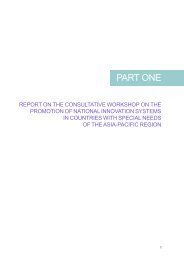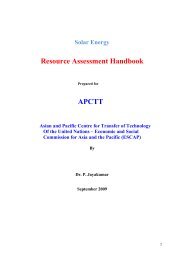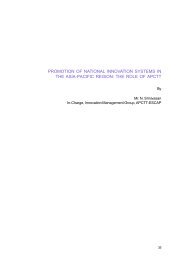Download Complete PDF - apctt
Download Complete PDF - apctt
Download Complete PDF - apctt
- No tags were found...
Create successful ePaper yourself
Turn your PDF publications into a flip-book with our unique Google optimized e-Paper software.
WEC’s 2007 survey on global energy resources makes the following observations oncoal:• For 200 years, coal was the major fuel for energy production as well as input toiron and steel manufacture and fuelled the Industrial Revolution;• Coal started loosing to oil as the principal source of primary energy and wasovertaken by oil in the 1960s;• Coal remains abundant and has once again become the most rapidly growing fuelon a global basis;• At the current rate of extraction, coal may last for 150 years;• Economically recoverable coal exists in over 70 countries, spread in all regions,and amounts to 850 billion tonnes.• At the close of the 20 th century, the share of different fuels in world’s commercialenergy consumption was: oil - 39 per cent, coal - 24 per cent, natural gas - 24 percent, nuclear power - 7 per cent, hydro and other renewables - 6 per cent;• In the year 2000, the total world coal consumption was 4,740 million tonnes. Theshare of Asia-Pacific (including Japan) was 44 per cent;• China is the world’s largest consumer of coal accounting for 23 per cent of globalcoal consumption, followed by the United States with 22 per cent and India with 7per cent;• Coal consumption has shown increases in he United States, Japan and mostdeveloping nations;• Fossil fuel will continue to provide 80 per cent of primary energy;• Coal will see the largest demand among fossil fuels, with China alone showing 30per cent increase in demand;• Global coal demand will grow from 2,772 million tonnes of oil equivalent (mtoe) in2004 to 4,441 mtoe in 2030;• Developing regions of Asia, where reserves are large and cost low, will witness 86per cent increase in coal consumption; and• India’s coal consumption will grow annually by 3.3 per cent till 2030.If coal is the solution, what is the problem? The major concerns are GHG (includingCO 2) emissions and their impact on climate change, as coal is the main culprit in GHGemissions. It is possible to contain coal-generated GHG emissions by adopting advancedcoal technologies such as: coal to liquids, clean coal, and carbon capture and storage(CCS).A. Improving efficiencies in coal-based power plantsA range of advanced coal combustion technologies have been developed to improvethe efficiency of coal-fired power generation. New, more efficient coal-fired combustiontechnologies reduce emissions of CO 2, as well as pollutants such as nitrogen oxides(NOx), sulphur oxides (SOx) and particulates.1. Improving efficiency levelsImproving efficiency levels increases the amount of energy that can be extracted froma single unit of coal. Increases in the efficiency of electricity generation are essential48







